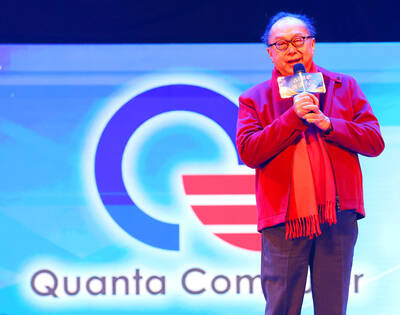LED chip suppliers Epistar Corp (晶元光電) and Formosa Epitaxy Inc (ForEpi, 璨圓光電) yesterday said the two companies plan to merge through a share-swap later this year to enhance their operating efficiency and competitiveness in the global market.
Epistar, the nation’s biggest LED chipmaker, said it plans to issue more than 170 million common shares to exchange for 586.16 million ForEpi shares based on a share-swap ratio of 3.448.
The share swap is to take effect on Dec. 30, the companies said.
Once the transaction is completed, ForEpi will become a wholly owned subsidiary of Epistar, with the merged entity holding more than NT$11 billion (US$368 million) in paid-in capital, as well as 6,700 employees.
The two companies said in a filing with the Taiwan Stock Exchange that the merger would integrate Epistar and ForEpi’s resources, expand the companies’ business scale and lower their management costs.
Based on Epistar’s closing share price of NT$74 yesterday and ForEpi’s NT$18.25, Epistar is offering a premium of 17.6 percent for ForEpi shares.
“The share swap will benefit shareholders of both companies. The deal is expected to have a positive impact on the two companies’ net value and earnings per share,” Epistar and ForEpi said in their filings.
The deal is still subject to approval by the two companies’ shareholders at their respective meetings on Sept. 1.
It is not certain if Epistar will consider delisting ForEpi from the local bourse, as messages left for the company were not answered yesterday.
Market researcher TrendForce Corp (集邦科技) said Epistar has 385 metal organic chemical vapor deposition (MOCVD) machines that are used to manufacture LED chips.
Together with ForEpi’s 103 MOCVD units, Epistar will have nearly 500 of the machines by the end of the year, higher than the 160 units owned by major Chinese rival Sanan Optoelectronics Co (三安光電).
“This merger will position Epistar well ahead of its competitors,” TrendForce analyst Joanne Wu (吳盈潔) said in an e-mailed statement.
Epistar ranks as the world's largest aluminum-gallium-indium-phosphide (AlGalnP) epitaxial wafer and chip supplier and the second-largest indium-gallium-nitride (InGaN) epitaxial wafer and chip maker.
Following the merger, Epistar will become the biggest vendor of both LED products and will have a 30-40 percent share of the global LED epitaxial wafer and chip market.
Other analysts said the deal would likely trigger a wave of consolidation in the LED industry, with major suppliers eyeing more production capacity to meet rising demand for LED lighting and LED backlight products.
“With a much larger capacity, Epistar can gain more competitiveness in winning new orders from clients, most likely international brands such as Koninklijke Philips NV and Osram GmbH,” Primasia Securities Co (犇亞證券) analyst Filia Lin said by telephone.
“It is very important for chipmakers like Epistar to expand capacity and increase the number of patents it has to win orders from large-sized lighting companies, which now more than ever are outsourcing orders to reduce costs,” she added.
But Lin said the merger is unlikely to help lift Epistar’s profitability until next year because of the transaction’s timing. She said Epistar is still expected to report weaker financial results for this and next quarters.
In the first quarter of the year, Epistar posted a net loss of NT$841.7 million, or a net loss per share of NT$0.91, with revenue of NT$6.24 billion.
Additional reporting by CNA

Intel Corp chief executive officer Lip-Bu Tan (陳立武) is expected to meet with Taiwanese suppliers next month in conjunction with the opening of the Computex Taipei trade show, supply chain sources said on Monday. The visit, the first for Tan to Taiwan since assuming his new post last month, would be aimed at enhancing Intel’s ties with suppliers in Taiwan as he attempts to help turn around the struggling US chipmaker, the sources said. Tan is to hold a banquet to celebrate Intel’s 40-year presence in Taiwan before Computex opens on May 20 and invite dozens of Taiwanese suppliers to exchange views

Application-specific integrated circuit designer Faraday Technology Corp (智原) yesterday said that although revenue this quarter would decline 30 percent from last quarter, it retained its full-year forecast of revenue growth of 100 percent. The company attributed the quarterly drop to a slowdown in customers’ production of chips using Faraday’s advanced packaging technology. The company is still confident about its revenue growth this year, given its strong “design-win” — or the projects it won to help customers design their chips, Faraday president Steve Wang (王國雍) told an online earnings conference. “The design-win this year is better than we expected. We believe we will win

Quanta Computer Inc (廣達) chairman Barry Lam (林百里) is expected to share his views about the artificial intelligence (AI) industry’s prospects during his speech at the company’s 37th anniversary ceremony, as AI servers have become a new growth engine for the equipment manufacturing service provider. Lam’s speech is much anticipated, as Quanta has risen as one of the world’s major AI server suppliers. The company reported a 30 percent year-on-year growth in consolidated revenue to NT$1.41 trillion (US$43.35 billion) last year, thanks to fast-growing demand for servers, especially those with AI capabilities. The company told investors in November last year that

Power supply and electronic components maker Delta Electronics Inc (台達電) yesterday said it plans to ship its new 1 megawatt charging systems for electric trucks and buses in the first half of next year at the earliest. The new charging piles, which deliver up to 1 megawatt of charging power, are designed for heavy-duty electric vehicles, and support a maximum current of 1,500 amperes and output of 1,250 volts, Delta said in a news release. “If everything goes smoothly, we could begin shipping those new charging systems as early as in the first half of next year,” a company official said. The new